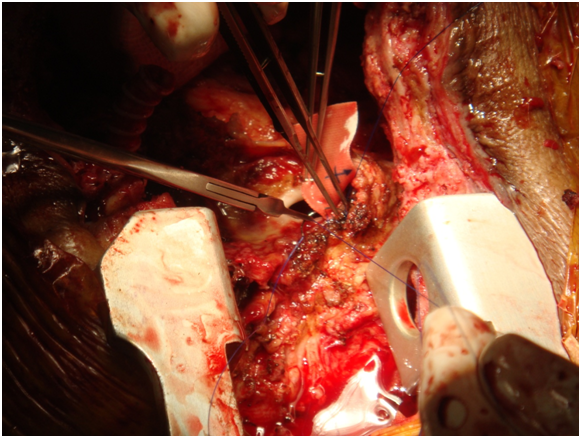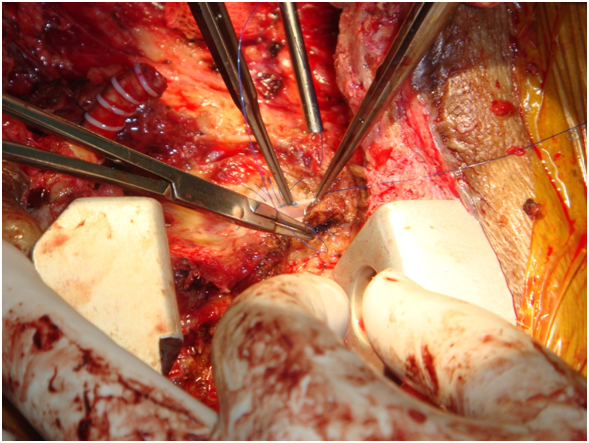Journal of
eISSN: 2373-4396


Case Report Volume 7 Issue 4
1Senior Registrar, Department of Cardiovascular and Thoracic Surgery, Apollo Hospitals, Dhaka
2Registrar, Department of Cardiovascular and Thoracic Surgery, Apollo Hospitals, Dhaka
3Department of Cardiovascular and Thoracic Surgery, Apollo Hospitals, Dhaka
4Department of Cardiothoracic Anesthesia, Apollo Hospitals, Dhaka
5Advanced Fellowship in Cardiovascular Surgery (Mayo Clinic-USA), Associate Professor and Senior Consultant, Department of Cardiac Surgery, National Heart Foundation Hospital, Dhaka
Correspondence: Muhammad Q I Talukder, Associate Professor and Senior Consultant, Department of Cardiac Surgery, National Heart Foundation Hospital, Dhaka, Tel 1791550783
Received: January 14, 2016 | Published: December 19, 2016
Citation: Zahangir NM, Ahmed ST, Ahmed F, Hossain N, Ahmed N, et al. (2016) Repair of Leaking Aortic Pseudoaneurysm due to Sternal Wound Infection in a Patient with CABG and Aorto-Axillary Bypass - A Case Report from Apollo Hospitals Dhaka. J Cardiol Curr Res 7(4): 00259 DOI: 10.15406/jccr.2016.07.00259
Background: Graft leakage at aortic site is a rare presentation in a postoperative case of Aorto- axillary bypass graft site with CABG. Surgical intervention gives good result.
Methods: A 55 years old gentleman came to our hospital with discharging chest wound with occasional episodes of bleeding through upper chest wound. One and half years back he was operated in another hospital with Aorto-axillary bypass with CABG. CT angiogram showed - Aorto- axillary bypass graft eroding sternum and developed a chronic leak in aortic side. Urgent operation was done on 1.08.13-we went to femoro-femoral bypass first-then very carefully sternotomy was done-found a leak around aortic side of the Aorto-axillary bypass graft. With gentle pressure on leak, proceeded for total circulatory arrest, graft was taken out, found oval shaped opening at ascending aorta, it was repaired by Dacron patch with continuous proline suture. Total circulatory arrest time was 37 minutes. Distal part of the graft on axillary artery found-a silk ligature applied-sternal wound reconstruction was done with pectoral is major muscle flap.
Results: The patient remained very well in ICU and was discharged from hospital on 7th post operative day in good general condition. Now more than 1 years follow up he is doing very well.
Conclusion: Graft leakage at aortic site of Aorto-axillary bypass graft is not a common entity, surgical intervention with Dacron patch repair gives good outcome. Surgical Repair of aortic pseudoaneurysm a though with high risk, is only remedy to save the life of the patient.
Keywords: Axillo-aortic bypass; Total circulatory arrest; Pectoralis major muscle flap
Aorto-axillary bypass is accepted surgical treatment for Subclavian Artery stenosis. Pseudoaneurysm may be a rare complication after this. Pseudoaneurysm located at the retrosternal space, there is risk of massive bleeding from rupture during performance of resternotomy. To avoid this risk femoro-femoral bypass with total circulatory arrest is greatly helpful.
A 55 years old gentleman came to our hospital with discharging chest wound with occasional bleeding through upper chest wound. He was also suffering from fever occasionally. One and half years back he was operated in another hospital with CABG with Aorto-axillary bypass. On 4th postoperative day he needs reopening for mediastinal bleeding and needed a long ICU stay. Then he developed above mentioned symptoms. 5 days back he developed severe bleeding and was treated conservatively in another hospital. After admission CT angiogram was done-showed-Aorto-axillary bypass graft penetrating sternum and developed a leak in the aortic side. We decided for urgent operation on next day on 1.08.13-we went to femoro-femoral bypass first [1].
Chest incision was very technical-started from below with oscillator saw upto upper 1/3rd of sternum near aneurysm. Now upper part from above-near aneurysm curved the saw to right avoiding the aneurysm, put small retractor now gradually cut through bony surface so not went into graft and go around aneurysm without rupturing it but suddenly aneurysn came to leak--now no way--gentle pressure on leak and proceeded for total circulatory arrest. During going to total circulatory arrest, dissection around heart was done through diaphragmatic surface and right side. Now at 180C total circulatory arrest was done, taken out graft, found oval shaped opening at ascending aorta, a Dacron patch taken and covered it by continuous proline suture.
Started rewarming and circulation, Distal part of graft on axillary artery found-a silk ligature applied- rest of the graft taken out. Weaning from CPB was done easily, sternal wound reconstruction was done with pectoral is major muscle flap. The patient was discharge from the hospital on 7th post operative in good general condition. Now more than 2 years follow up he is doing very well [2] (Figures 1-10).


Aorto-axillary bypass is accepted intervention to treat Subclavian Artery stenosis. Pseudoaneurysm of the ascending aorta is a rare complication after surgery. Particularly, pseudoaneurysm due to postoperative infection in the ascending aorta requires surgical treatment. If a pseudoaneurysm is located at the retrosternal space, then there is a very high risk of massive bleeding from rupture during performance of resternotomy [3]. To avoid this risk, we performed femoro-femoral bypass with total circulatory arrest.
In some patients, the progressive growth of an aortic pseudoaneurysm can erode the bony structures of the sternum. The use of appropriate technique will avoid catastrophic hemorrhage during sternotomy. The chief objectives are to control the aortic defect during mediastinal dissection and to preserve adequate cerebral perfusion. Hypothermic circulatory arrest, which is used to control the depletion of intravascular volume and to enable the preservation of cerebral function, provides time to perform the mediastinal dissection and to control the aortic defect. Sudden and extreme blood loss can be avoided by using this approach. When a false aneurysm has eroded the bony structures in the chest, the surgeon's challenge is to choose an approach for sternotomy that enables safe entry [4].
Infection of a vascular prosthesis is serious complication that may occur after implantation and dramatically affects the patient's outcome. Surgical treatment is almost always required but even after surgery, morbidity can be significant. Complete resection of the infected foreign material with debridement of the surrounding tissue gives better results. If a decision is made to remove the infected implant, complete extraction of all components is essential, if surgically feasible [5].
Graft leakage at aortic site of Aorto- axillary bypass graft is not a common entity, surgical intervention with Dacron patch repair gives good outcome. Surgical Repair of aortic pseudoaneurysm a though with high risk, is only remedy to save the life of the patient.

©2016 Zahangir, et al. This is an open access article distributed under the terms of the, which permits unrestricted use, distribution, and build upon your work non-commercially.